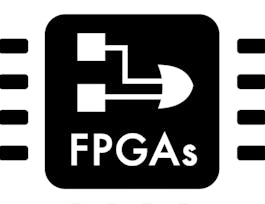This course gives you a complete insight into the modern design of digital systems fundamentals from an eminently practical point of view. Unlike other more "classic" digital circuits courses, our interest focuses more on the system than on the electronics that support it. This approach will allow us to lay the foundation for the design of complex digital systems.


Digital Systems: From Logic Gates to Processors
Taught in English
82,698 already enrolled
(742 reviews)
Skills you'll gain
Details to know

Add to your LinkedIn profile
17 quizzes
See how employees at top companies are mastering in-demand skills


Earn a career certificate
Add this credential to your LinkedIn profile, resume, or CV
Share it on social media and in your performance review

There are 12 modules in this course
<b><font size=4 color=#B22222><b>Click on "v More" to read the purpose of this module</b></font></b> <br/><br/>We have collected here everything you need to know before starting the course. <br/><br/>This week is divided into three sections: <br/><ul><li>The first is the one you're reading about now and includes a number of general explanations about how the course will run and about the virtual machine you should install on your computer to answer the different quizzes . </li><li>The second (<i><b>Previous knowledge: A review</i></b>) presents a series of tests you can use to check your level of knowledge about numbering systems and the use of pseudocode to describe algorithms. </li><li>The third block contains the first real topic of the course: <i><b>What Digital Systems are?</b></i></li></ul>
What's included
1 video10 readings
<b>Check your knowledge about binary and hexadecimal numbering systems, and the description of algorithms using a pseudocode</b>
What's included
2 videos2 readings2 quizzes
<b><font size=4 color=#B22222><b>Click on "v More" to read the purpose of this module</b></font> </b> <br/><br/>This module is an introduction to Digital Systems. Here you will find:<ol><li>A set of videos_L covering issue 1 and the corresponding exercises, </li><li>Two videos_P introducing the processor that we will design along the course, and</li><li>Some video-based explanations; a wiki and some FAQs about how VerilUOC_Desktop tool functions.<br/> You will have to use VerilUOC_Desktop in the next module</li></ol> Read the "Lesson Index" in the "Index and PDF files" section and the "README" in the VerilUOC_Desktop section for more information.
What's included
5 videos3 readings2 quizzes
<b><font size=4 color=#B22222><b>Click on "v More" to read the purpose of this module</b></font> </b> <br/><br/>This module introduces combinational circuits, logic gates and boolean algebra, all of them items necessary to design simple combinational circuits.<br/> Read the "Index of lessons" for more information. <br/><br/><b>To solve the exercises in this module you will need to use VerilUOC_Desktop. Look at the module "VerilUOC_Desktop tools" to learn how to use it.</b>
What's included
5 videos3 readings2 quizzes
<b><font size=4 color=#B22222><b>Click on "v More" to read the purpose of this module</b></font> </b><br/><br/>From this week you will need to use VerilUOC_Desktop to do some of the exercises in the quizzes. VerilUOC_Desktop is a software package based on Logisim, enhanced with a number of modules to enable:<ul><li>Enter Boolean equations (BoolMin),</li><li>Enter digital circuits and check them according the problem statement (VerilCirc), and</li><li>Enter chronograms (time-charts) and check that they are correct (VerilChart).</li></ul>This section contains two videos explaining how these three tools work. By now you only need to use VerilCirc and BoolMin, so if you are pushed for time, you might postpone VerilChart for later. Obviously, it is impossible to cover in these two videos all eventualities you can find while working with VerilUOC_Desktop tools. In case of doubt, look at the VerilUOC_Desktop wiki, look at the FAQs or post your problems in the forums. There are specific forums for VerilCirc, BoolMin and VerilChart.
What's included
2 videos3 readings
<b><font size=4 color=#B22222><b>Click on "v More" to read the purpose of this module</b></font> </b> <br/><br/>We continue the study of combinational circuits. While in the previous module we were working on the classical design techniques of combinational circuits, this one is focused on other issues such as a brief introduction to computer aided design tools (CAD tools), or the direct synthesis of combinational circuits from its algorithmic description.<br/> Read the "Lesson index" for more information. <br><br/><b>To solve the exercises in this module VerilUOC_Desktop is needed. </b>Remember that the "VerilUOC_Desktop" section in module 2 contains all the information you need about this tool.
What's included
5 videos3 readings2 quizzes
<b><font size=4 color=#B22222><b>Click on "v More" to read the purpose of this module</b></font> </b><br/><br/>Arithmetic circuits are an essential part of many digital circuits and thus deserve a particular treatment. <ul><li> The first part of this module presents some implementations of the basic arithmetic operations. Only operations with naturals (non-negative integers) are considered. </li><li>The second part of this module introduces the basics of VHDL with the goal of providing enough knowledge to understand its usage throughout this course and start developing basic hardware models.</li></ul>
What's included
10 videos9 readings1 quiz
<b><font size=4 color=#B22222><b>Click on "v More" to read the purpose of this module</b></font> </b><br/><br/>This is the first module dedicated to Sequential Circuits (Digital Systems with Memory).<br/> <b>To solve the quizzes you will need VerilUOC_Desktop</b>. Remember that the first week includes a complete description of VerilUOC_Desktop. In particular, VerilChart is presented in the second video.
What's included
7 videos3 readings2 quizzes
<b><font size=4 color=#B22222><b>Click on "v More" to read the purpose of this module</b></font> </b><br/><br/>This second module dedicated to Sequential Circuits deals with particular sequential circuits that are building blocks of larger circuits, namely registers, counters and memory blocks.
What's included
4 videos3 readings2 quizzes
<b><font size=4 color=#B22222><b>Click on "v More" to read the purpose of this module</b></font> </b><br/><br/>This module deals with two topics: <ol><li>In previous lessons, the relation between algorithms (programming language structures) and combinational circuits has been commented. This relation also exists between algorithms and sequential circuits. We will explore this relation in the current module.</li><li>The second topic we will see is the definition and VHDL modelling of Finite State Machines.</li></ol>
What's included
5 videos4 readings2 quizzes
<b><font size=4 color=#B22222><b>Click on "v More" to read the purpose of this module</b></font> </b><br/><br/>This last module presents some basic information about manufacturing technologies, as well as about implementation strategies, and synthesis and implementation tools.
What's included
4 videos2 readings2 quizzes
´´
What's included
3 readings
Instructors



Offered by
Recommended if you're interested in Electrical Engineering

University of Colorado Boulder

Pontificia Universidad Católica de Chile

Princeton University

University of Colorado Boulder
Why people choose Coursera for their career




Learner reviews
Showing 3 of 742
742 reviews
- 5 stars
63.07%
- 4 stars
22.77%
- 3 stars
6.19%
- 2 stars
2.02%
- 1 star
5.92%

Open new doors with Coursera Plus
Unlimited access to 7,000+ world-class courses, hands-on projects, and job-ready certificate programs - all included in your subscription
Advance your career with an online degree
Earn a degree from world-class universities - 100% online
Join over 3,400 global companies that choose Coursera for Business
Upskill your employees to excel in the digital economy
Frequently asked questions
You can request the certificate at any time: before, during or once you finish the course.
· The course name
· The instructor's signature
· The logo of the partner institution offering the course
· A verification URL that allows others to check the Certificate's authenticity
· A statement that Coursera has confirmed the identity of the learner who completed the course
· Academic credit from the partner institution offering the course
· The final grade you got in the course
· Your ID photo
· The hours you spent working on coursework
· A printed or mailed copy of the Course Certificate.
Certificates are provided as downloadable PDF files, which you can print yourself. You can also share them electronically.
Unfortunately, Coursera cannot provide course Certificates with any more information than they already include.






